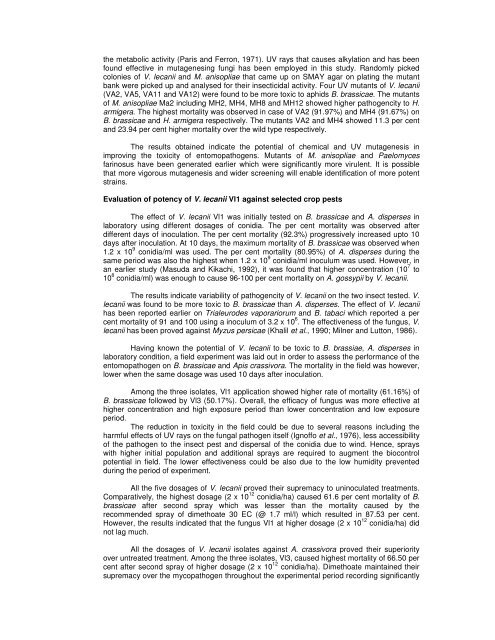ISOLATION AND CHARACTERIZATION OF ENTOMOPATHOGENIC ...
ISOLATION AND CHARACTERIZATION OF ENTOMOPATHOGENIC ...
ISOLATION AND CHARACTERIZATION OF ENTOMOPATHOGENIC ...
You also want an ePaper? Increase the reach of your titles
YUMPU automatically turns print PDFs into web optimized ePapers that Google loves.
the metabolic activity (Paris and Ferron, 1971). UV rays that causes alkylation and has been<br />
found effective in mutagenesing fungi has been employed in this study. Randomly picked<br />
colonies of V. lecanii and M. anisopliae that came up on SMAY agar on plating the mutant<br />
bank were picked up and analysed for their insecticidal activity. Four UV mutants of V. lecanii<br />
(VA2, VA5, VA11 and VA12) were found to be more toxic to aphids B. brassicae. The mutants<br />
of M. anisopliae Ma2 including MH2, MH4, MH8 and MH12 showed higher pathogencity to H.<br />
armigera. The highest mortality was observed in case of VA2 (91.97%) and MH4 (91.67%) on<br />
B. brassicae and H. armigera respectively. The mutants VA2 and MH4 showed 11.3 per cent<br />
and 23.94 per cent higher mortality over the wild type respectively.<br />
The results obtained indicate the potential of chemical and UV mutagenesis in<br />
improving the toxicity of entomopathogens. Mutants of M. anisopliae and Paelomyces<br />
farinosus have been generated earlier which were significantly more virulent. It is possible<br />
that more vigorous mutagenesis and wider screening will enable identification of more potent<br />
strains.<br />
Evaluation of potency of V. lecanii Vl1 against selected crop pests<br />
The effect of V. lecanii Vl1 was initially tested on B. brassicae and A. disperses in<br />
laboratory using different dosages of conidia. The per cent mortality was observed after<br />
different days of inoculation. The per cent mortality (92.3%) progressively increased upto 10<br />
days after inoculation. At 10 days, the maximum mortality of B. brassicae was observed when<br />
1.2 x 10 9 conidia/ml was used. The per cent mortality (80.95%) of A. disperses during the<br />
same period was also the highest when 1.2 x 10 9 conidia/ml inoculum was used. However, in<br />
an earlier study (Masuda and Kikachi, 1992), it was found that higher concentration (10 7 to<br />
10 8 conidia/ml) was enough to cause 96-100 per cent mortality on A. gossypii by V. lecanii.<br />
The results indicate variability of pathogencity of V. lecanii on the two insect tested. V.<br />
lecanii was found to be more toxic to B. brassicae than A. disperses. The effect of V. lecanii<br />
has been reported earlier on Trialeurodes vaporariorum and B. tabaci which reported a per<br />
cent mortality of 91 and 100 using a inoculum of 3.2 x 10 6 . The effectiveness of the fungus, V.<br />
lecanii has been proved against Myzus persicae (Khalil et al., 1990; Milner and Lutton, 1986).<br />
Having known the potential of V. lecanii to be toxic to B. brassiae, A. disperses in<br />
laboratory condition, a field experiment was laid out in order to assess the performance of the<br />
entomopathogen on B. brassicae and Apis crassivora. The mortality in the field was however,<br />
lower when the same dosage was used 10 days after inoculation.<br />
Among the three isolates, Vl1 application showed higher rate of mortality (61.16%) of<br />
B. brassicae followed by Vl3 (50.17%). Overall, the efficacy of fungus was more effective at<br />
higher concentration and high exposure period than lower concentration and low exposure<br />
period.<br />
The reduction in toxicity in the field could be due to several reasons including the<br />
harmful effects of UV rays on the fungal pathogen itself (Ignoffo et al., 1976), less accessibility<br />
of the pathogen to the insect pest and dispersal of the conidia due to wind. Hence, sprays<br />
with higher initial population and additional sprays are required to augment the biocontrol<br />
potential in field. The lower effectiveness could be also due to the low humidity prevented<br />
during the period of experiment.<br />
All the five dosages of V. lecanii proved their supremacy to uninoculated treatments.<br />
Comparatively, the highest dosage (2 x 10 12 conidia/ha) caused 61.6 per cent mortality of B.<br />
brassicae after second spray which was lesser than the mortality caused by the<br />
recommended spray of dimethoate 30 EC (@ 1.7 ml/l) which resulted in 87.53 per cent.<br />
However, the results indicated that the fungus Vl1 at higher dosage (2 x 10 12 conidia/ha) did<br />
not lag much.<br />
All the dosages of V. lecanii isolates against A. crassivora proved their superiority<br />
over untreated treatment. Among the three isolates, Vl3, caused highest mortality of 66.50 per<br />
cent after second spray of higher dosage (2 x 10 12 conidia/ha). Dimethoate maintained their<br />
supremacy over the mycopathogen throughout the experimental period recording significantly
















